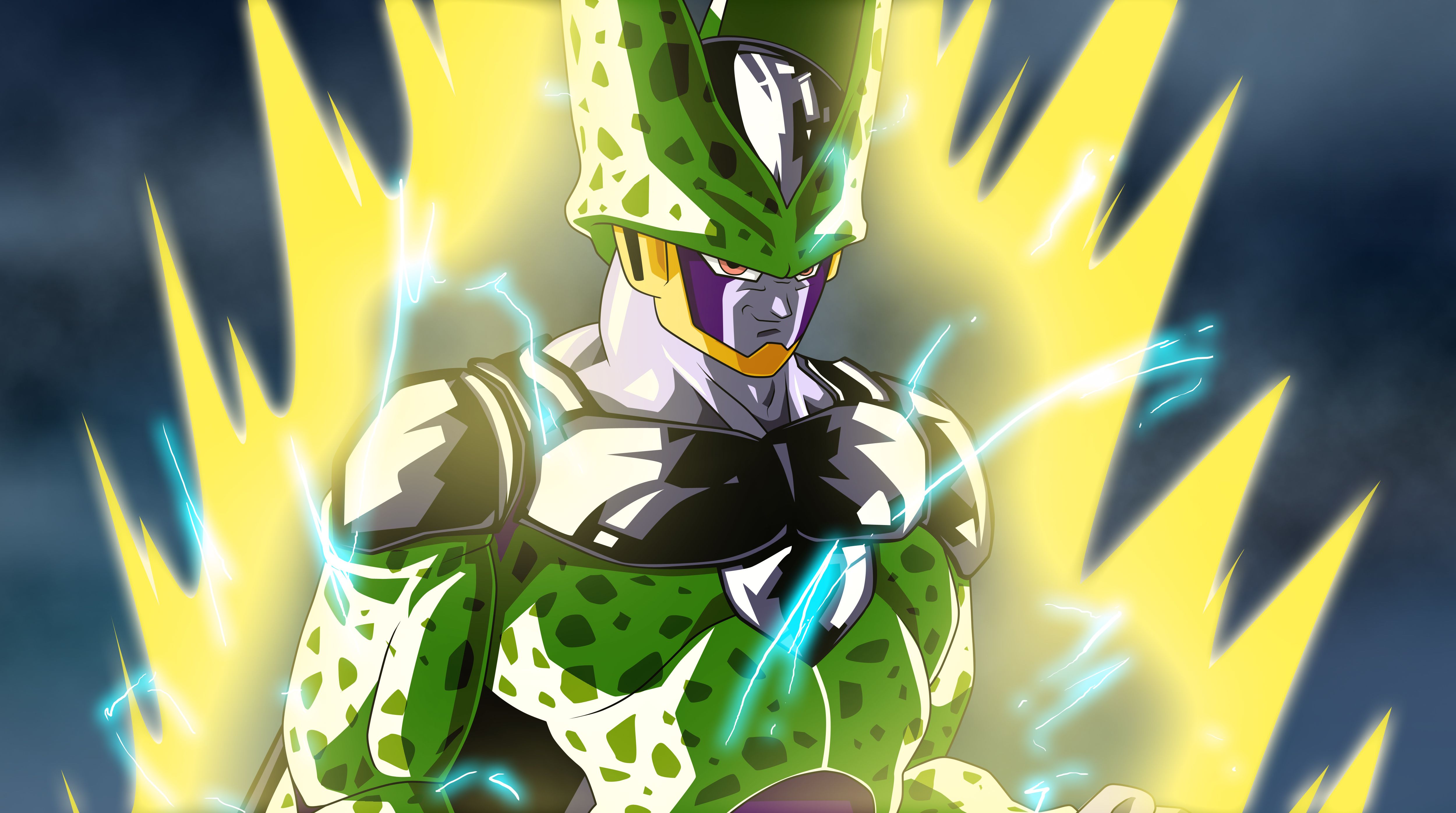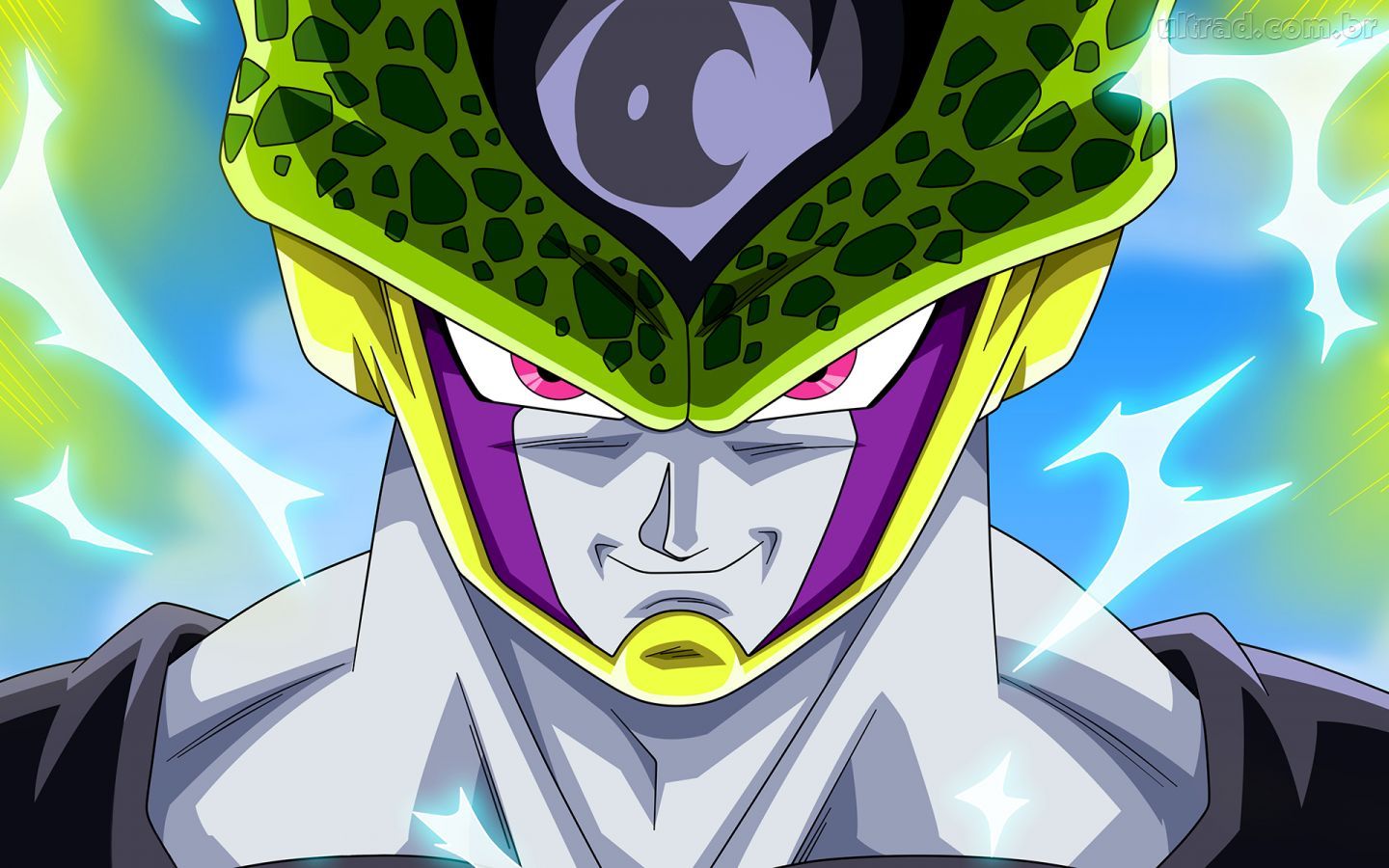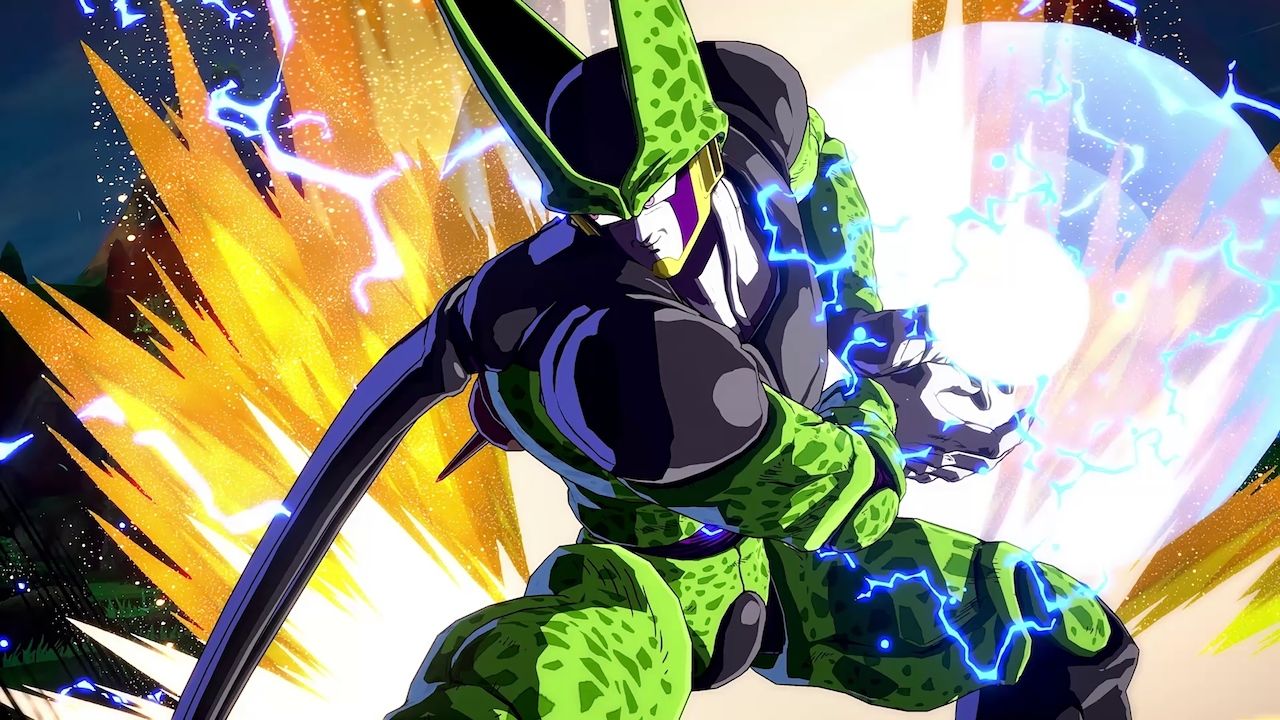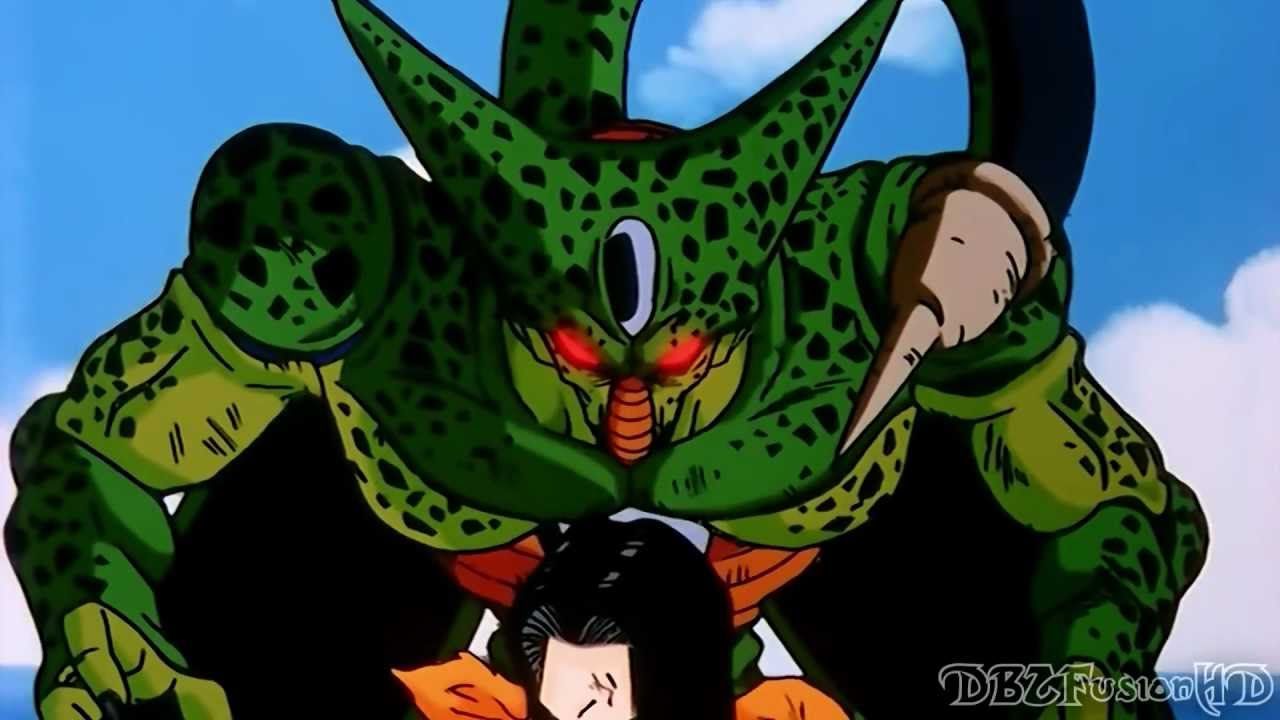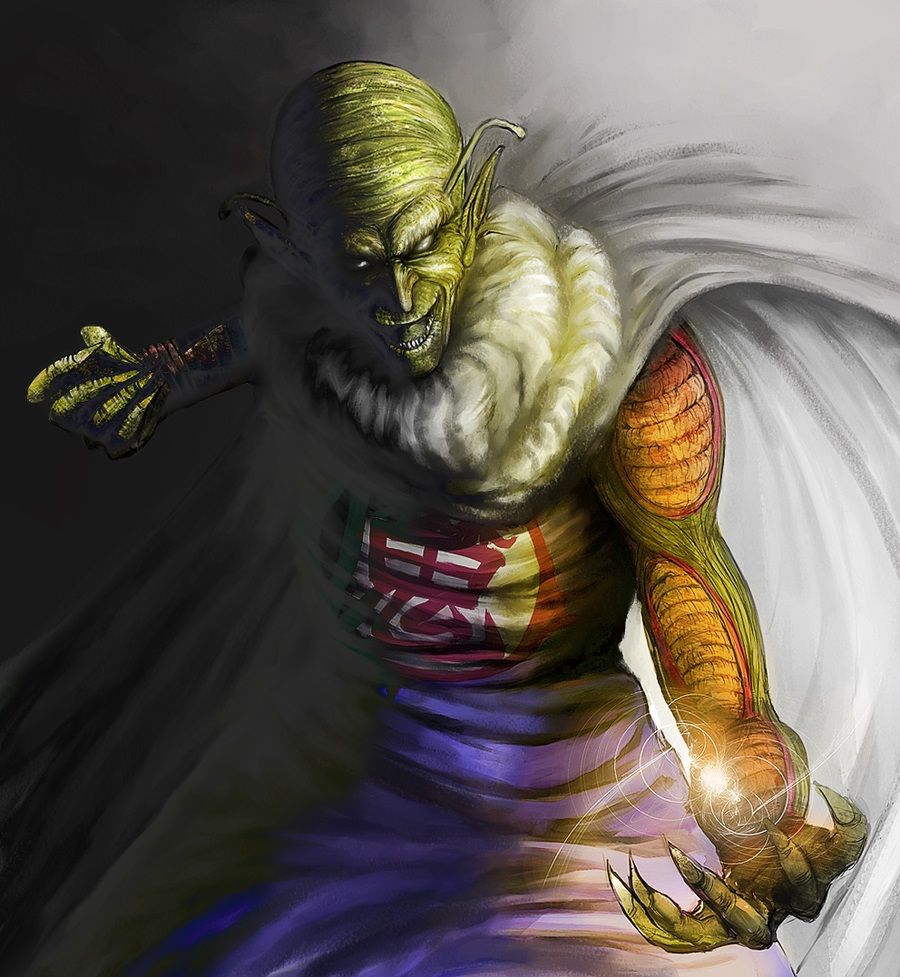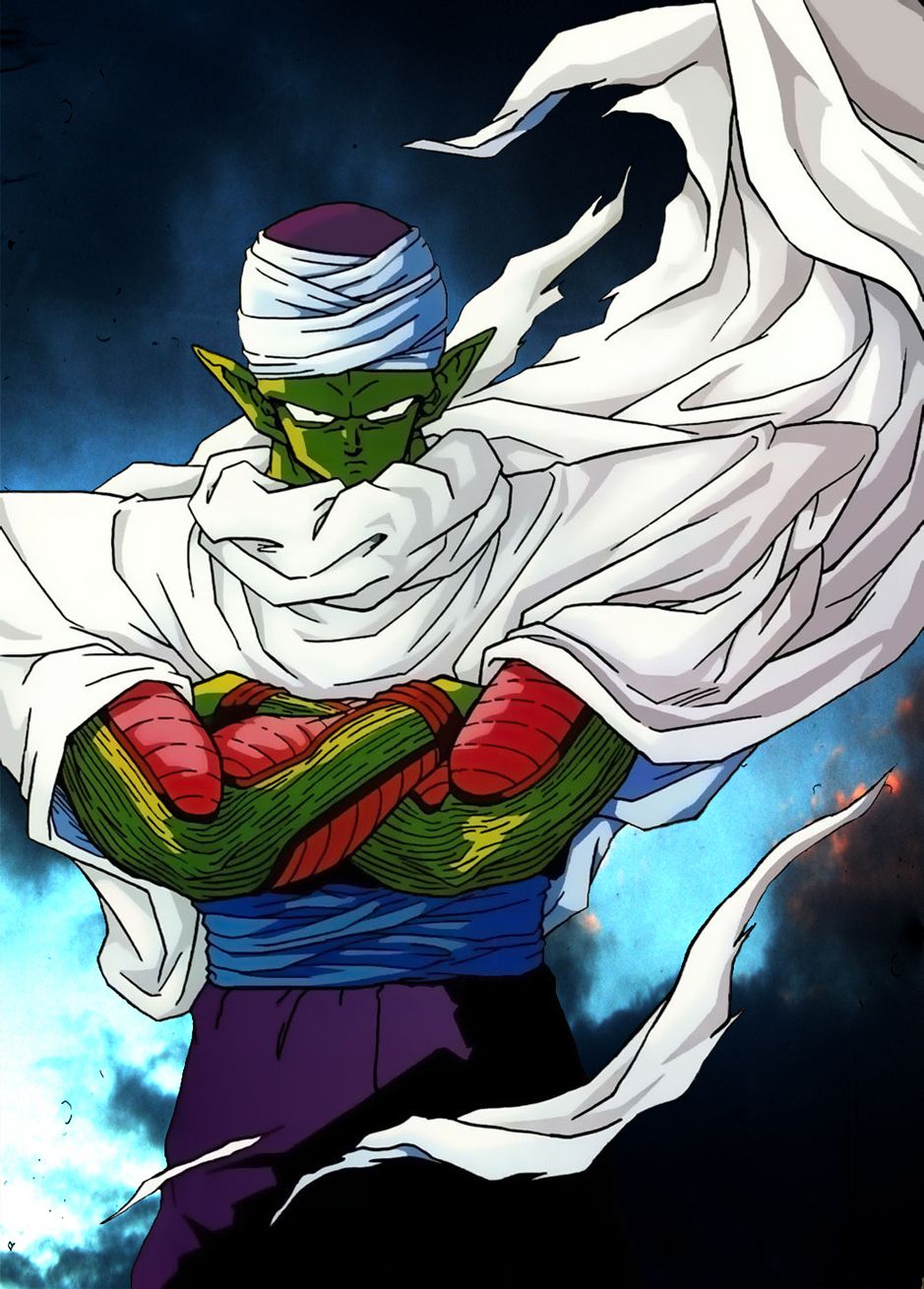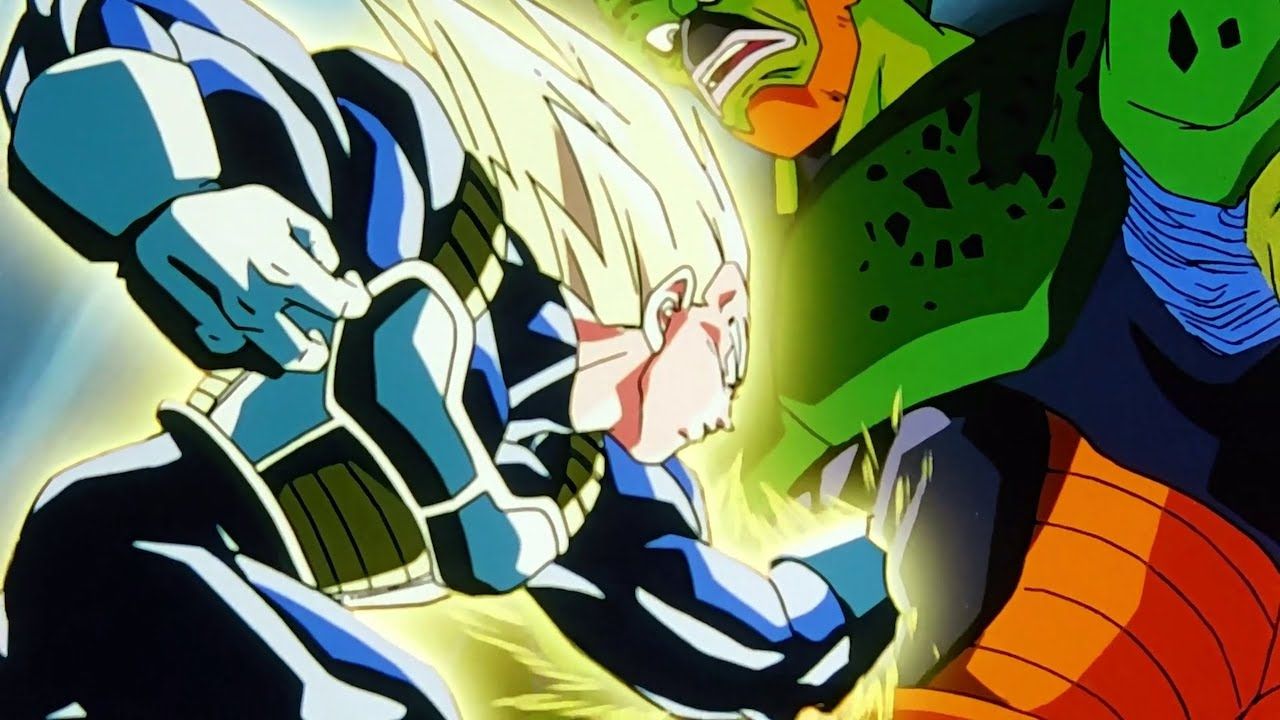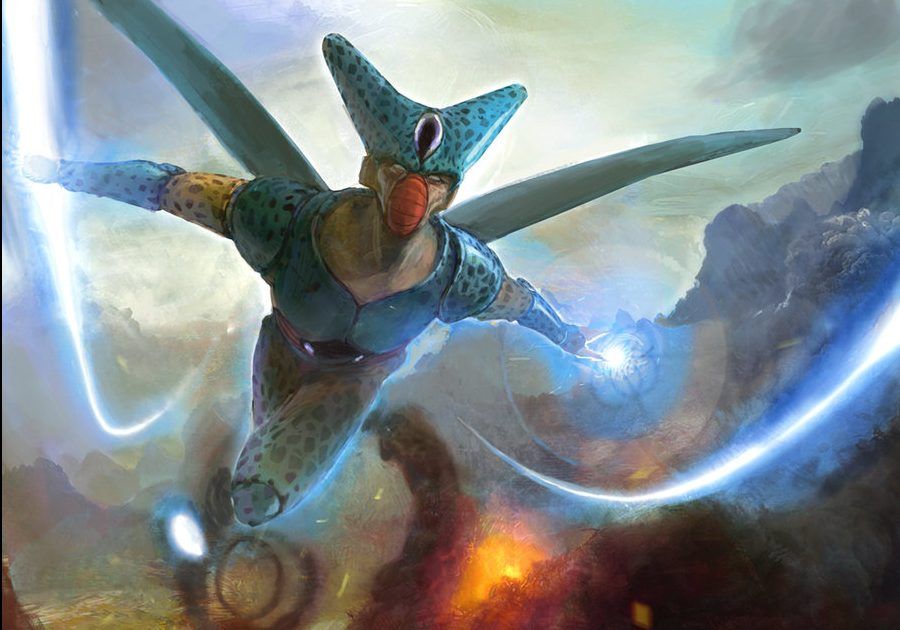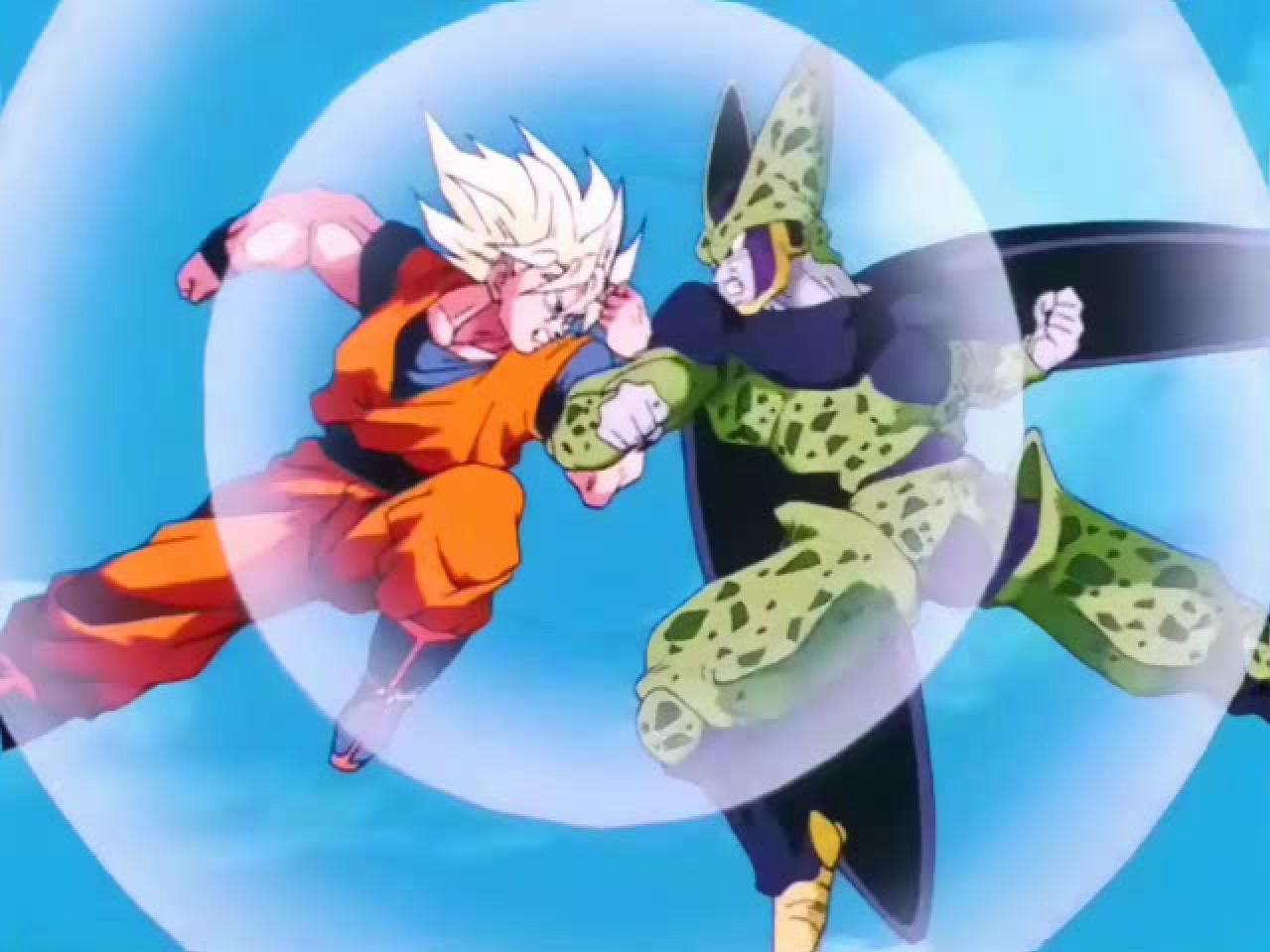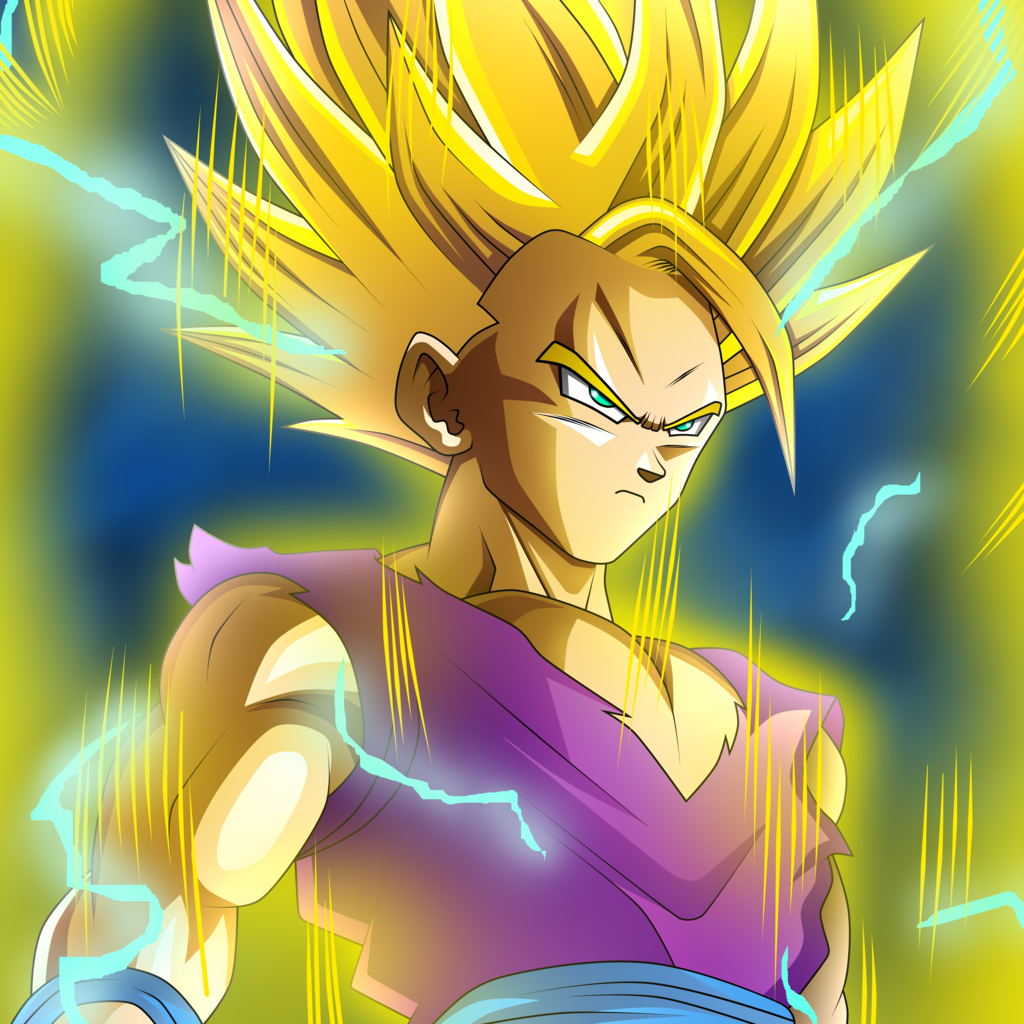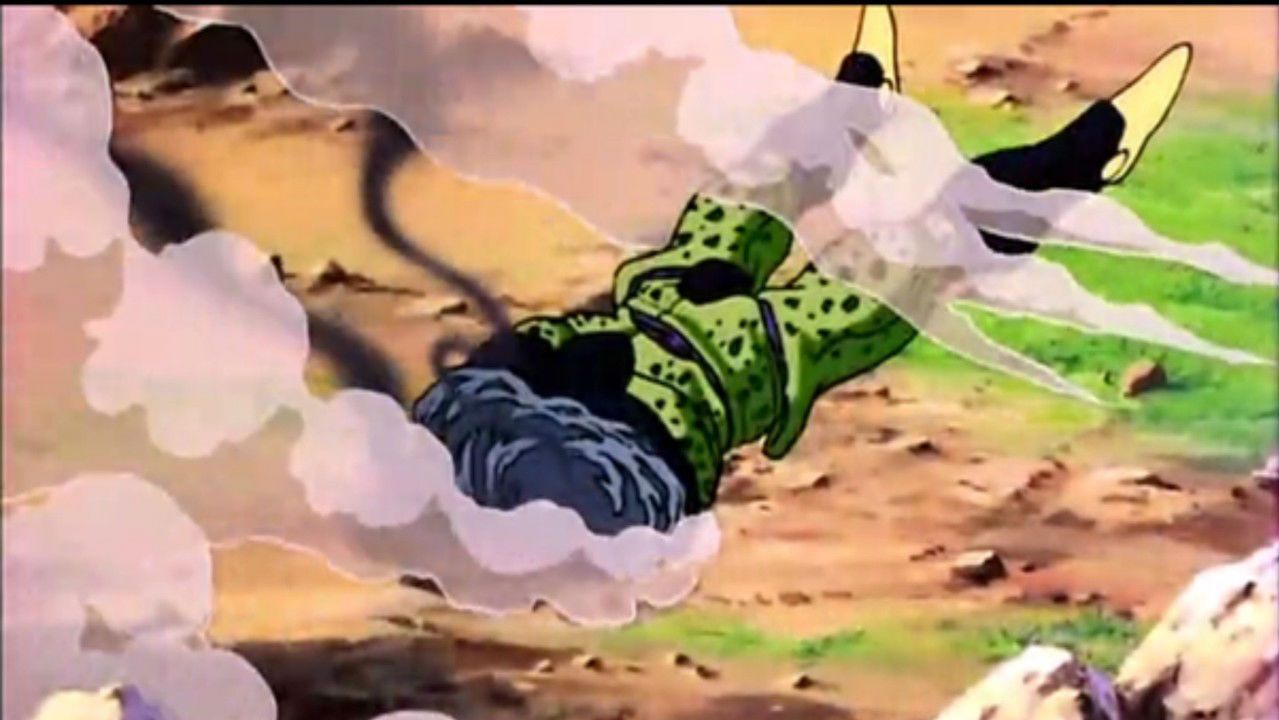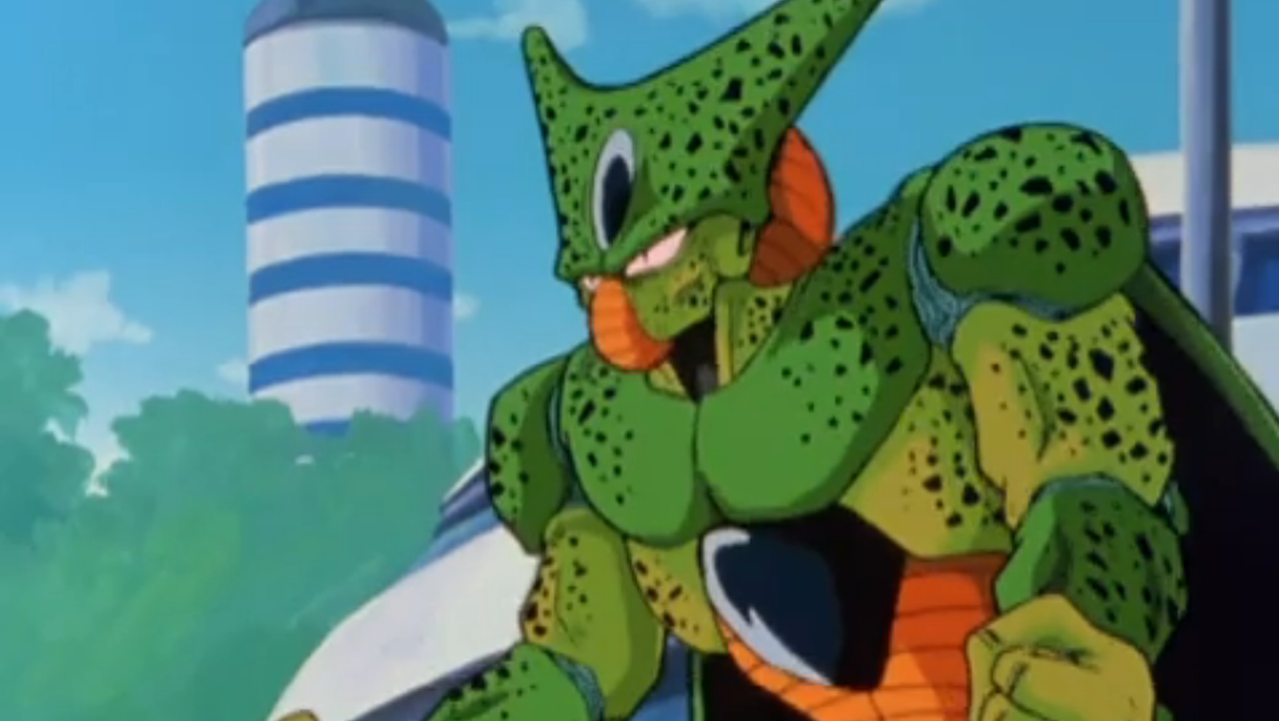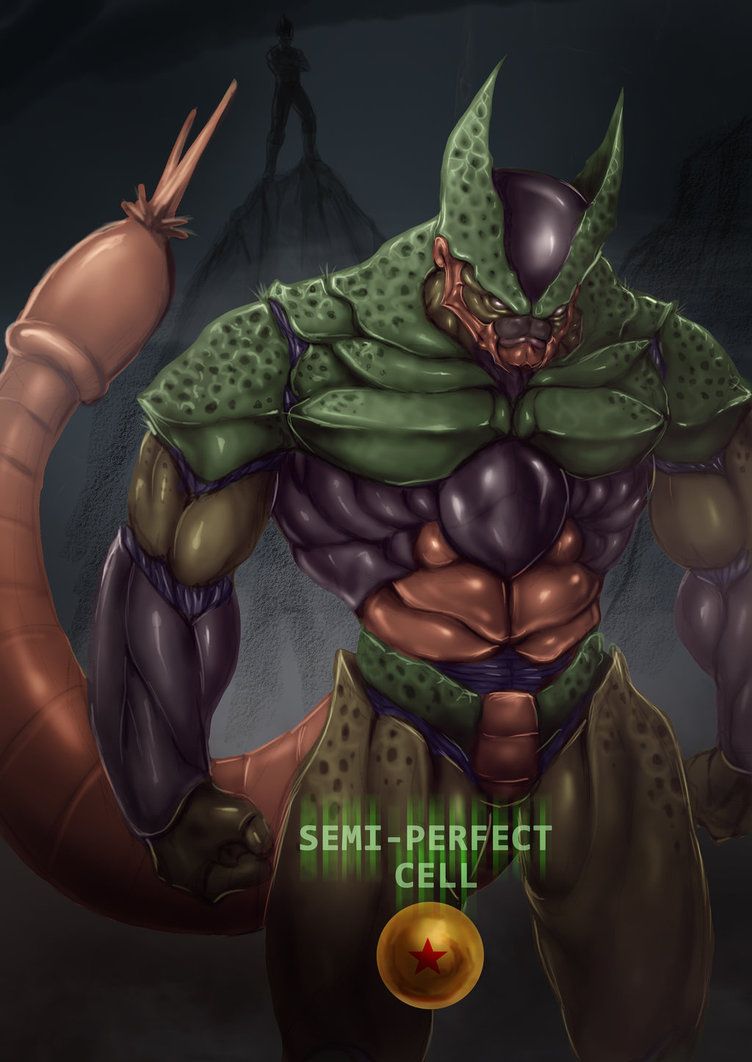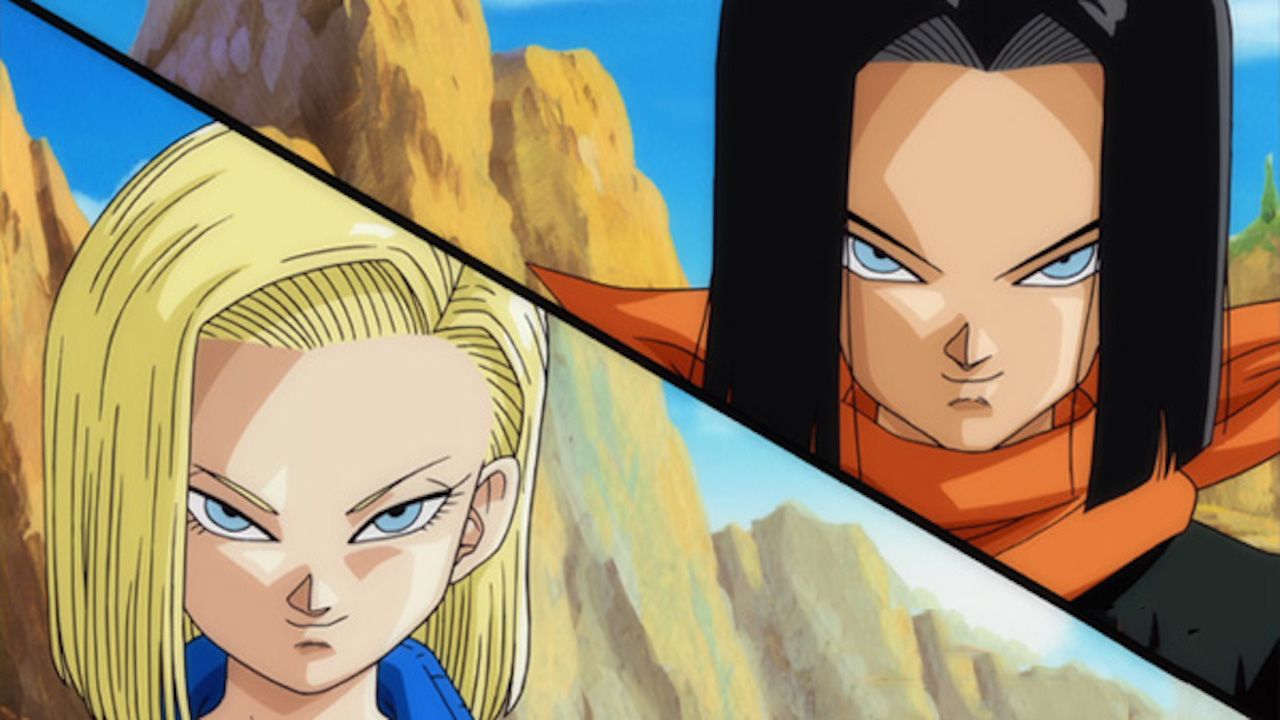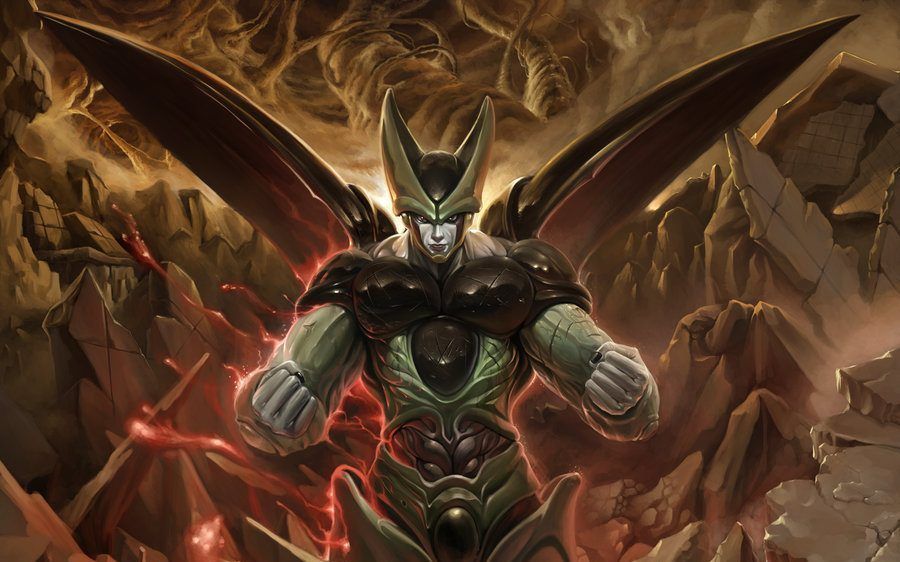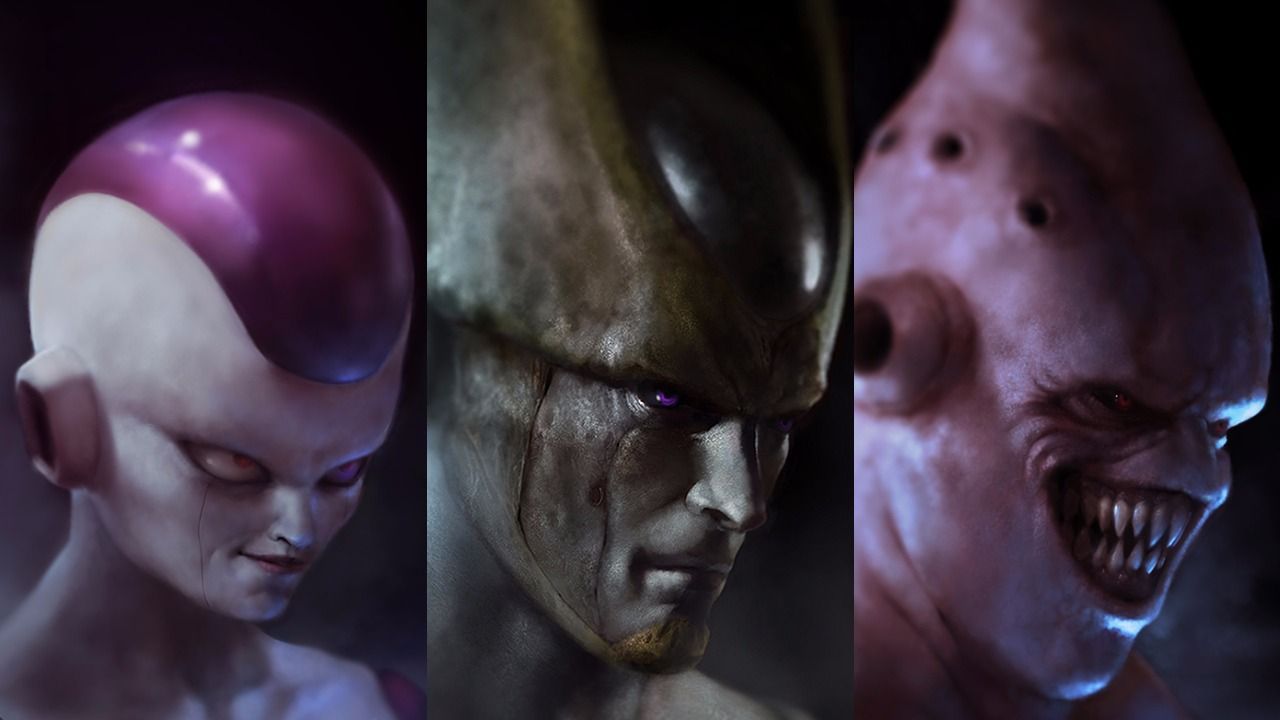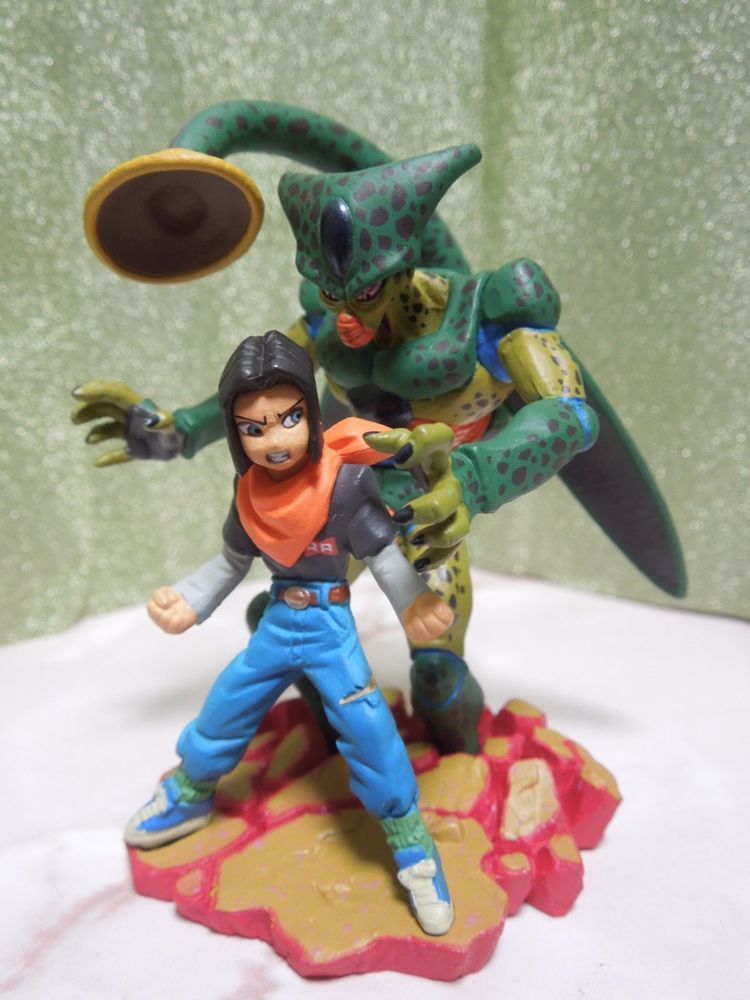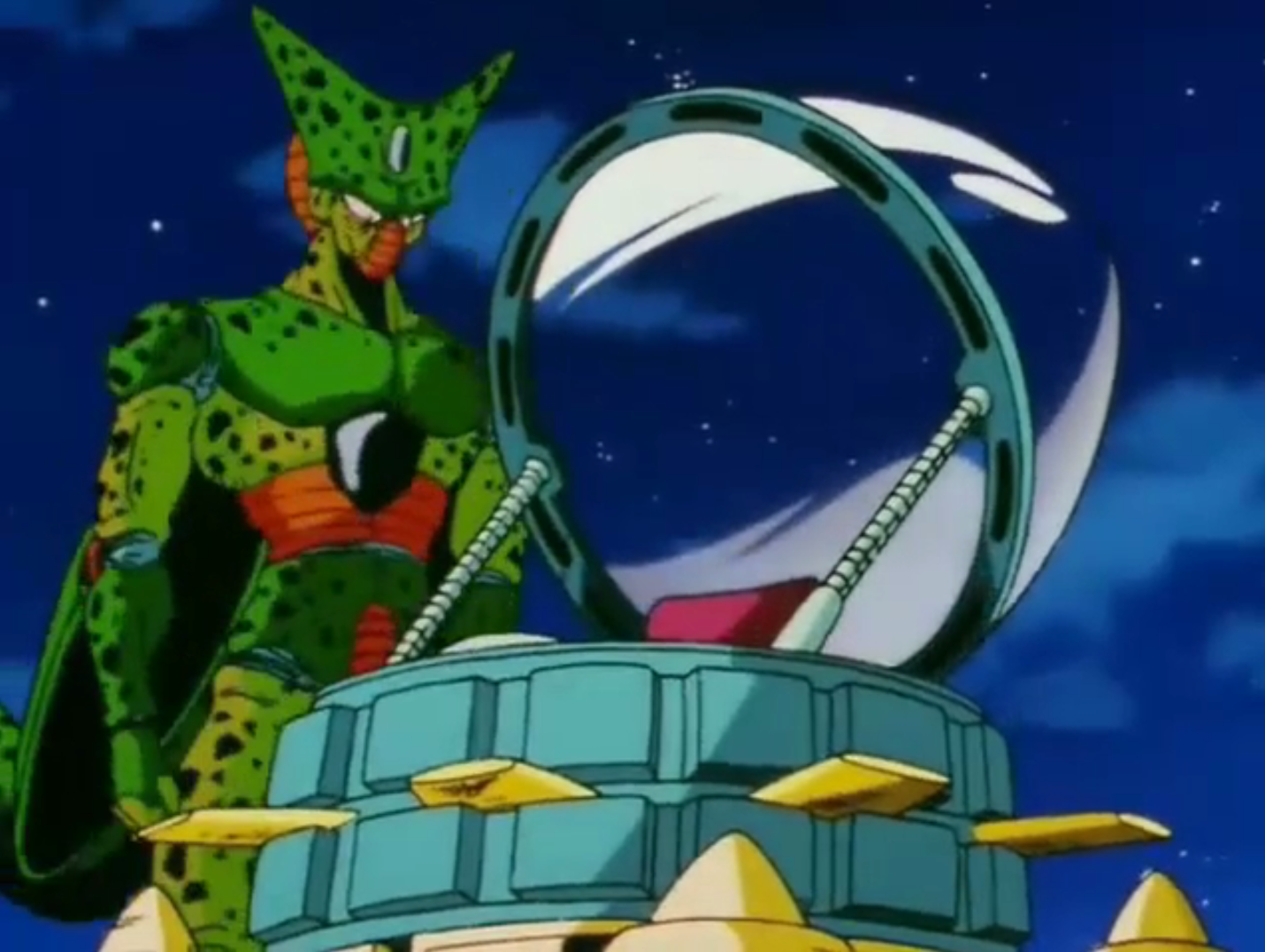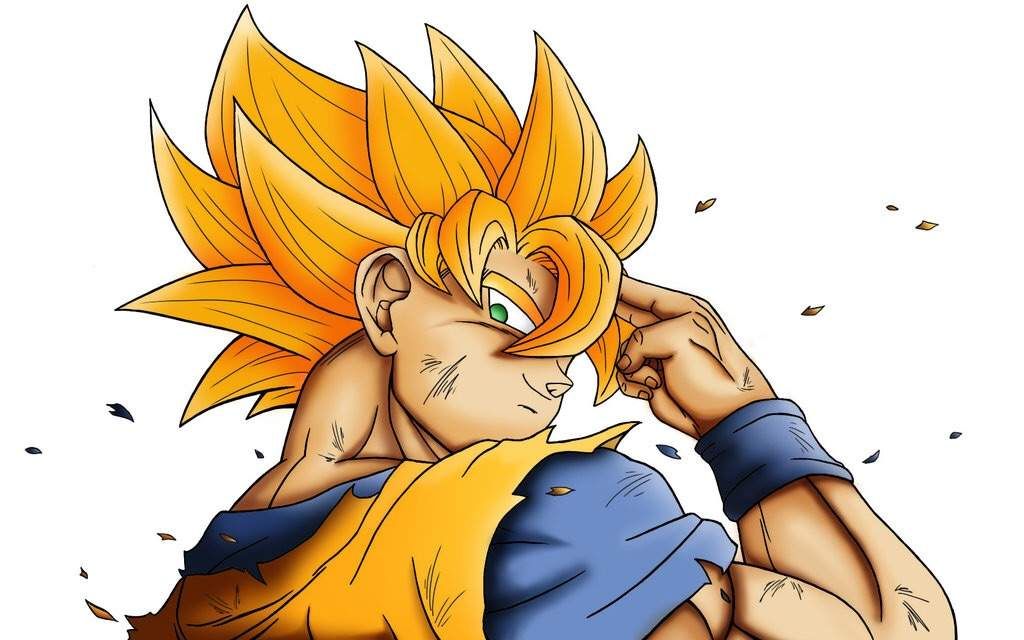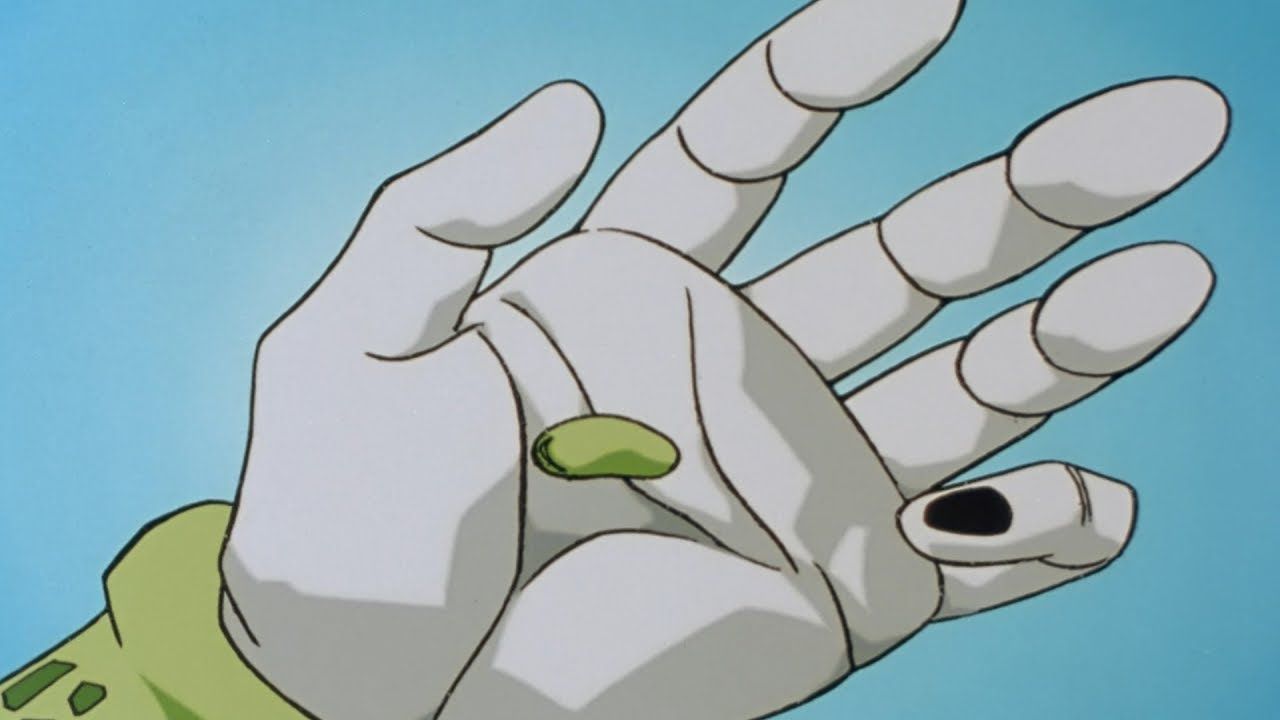He’s lean, he’s mean, he’s green, and he’s everybody’s favorite Android: Cell! I had to add that last bit in otherwise you’d think I was talking about Piccolo. The main villain of the Cell saga, Cell is easily one of the most fascinating characters in the franchise. Not only does he only appear for the first time halfway through his own arc, he’s actually a mashup of all your favorite characters. A biological soup of Goku’s, Vegeta’s, Piccolo’s, King Cold’s, and Frieza’s DNA, Cell is one of the most formidable characters in the series just on a conceptual level.
As a literal artificial human, there’s quite a lot going on in Cell’s body. He’s part Saiyan, part Namekian, and part whatever in the world Frieza and King Cold are. That alone gives him a biological makeup unlike any other, driving his actions in an almost unpredictable manner. Each time Cell transforms, his body undergoes a complete physiological shift, giving him new abilities and personality traits all while making him all the more dangerous. It’s not unheard of for Dragon Ball characters to end up with weird bodies, but Cell arguably has the weirdest. At the very least, he has the most interesting.
25 Cell Has The Last Zenkai We See In The Series
Let’s talk about Super Perfect Cell. The final iteration of the Cell arc’s titular villain, Super Perfect Cell rubs his ugly mug in our faces right after Goku’s heartfelt sacrifice, adding injury to the insult of Goku’s untimely demise. He immediately eliminates Future Trunks, gravely injures Super Saiyan 2 Gohan, and goes on to nearly destroy the entire planet with a rage-fueled Kamehameha. Gohan was handling the situation perfectly before Cell self-destructed so what gives? Why is Perfect Cell so strong all of sudden? It’s simple. He underwent a Zenkai. Not just any Zenkai, either, the last Zenkai we ever see in the main series.
Fun fact: Cell's one of three characters to undergo an on-screen Zenkai.
When a Saiyan is pushed to the edge of their life and then heals themselves fully, they undergo a biological shift called a Zenkai. These Zenkais permanently amplify their strength, allowing them to fight harder than ever. This is precisely how Goku and Vegeta get so strong on Namek. Since Cell is made up of both Goku’s and Vegeta’s DNA, Perfect Cell can technically undergo Zenkais of his own. When he self-destructs himself, he’s able to restore his body thanks to one lone cell. Since Cell was truly on the brink, this gives him a Zenkai unlike any other. That doesn’t explain the lightning, though…
24 Super Perfect Cell Is Technically A Super Saiyan
You know what’s even cooler than Cell undergoing a Zenkai after self-destructing? Cell becoming a literal Super Saiyan thanks to said Zenkai. Yeah, those lightning bolts aren’t just for show, Super Perfect Cell is a genuine Super Saiyan and that’s your visual cue. It’s implied throughout the Frieza saga that Zenkais are a way of pushing a Saiyan to their Super Saiyan state and Cell gets the mother of all Zenkais. On top of not being a full-blooded Saiyan, but still having the cells of some, he likely doesn’t need as many Zenkais to trigger his body’s version of Super Saiyan.
Cell gaining his own version of Super Saiyan mirrors Gohan breaking into Super Saiyan 2 quite well, along with hammering home one of the Cell saga’s main themes: ascending the natural Super Saiyan state. The entire last act of the arc is about Goku, Vegeta, and Future Trunks all trying to break past SSJ only for Gohan to do it out of sheer talent. Unfortunately for Cell, his Super form really only helps him sneak attack Future Trunks and Gohan. As soon as Gohan gets the upper hand in their beam struggle, he very easily vaporizes Cell away.
23 Cell Actually Starts Out Super Weak
For as formidable as Cell becomes by the end of his own arc, he actually starts out far weaker than arguably any other major villain in Dragon Ball Z. In his introductory fight against Piccolo, Imperfect Cell actually comes dangerously close to losing and the only reason he survives is because Piccolo is keeping him alive for questioning. Since Cell is a character who only gets stronger by absorbing other people, it makes sense he’d start out so weak. More importantly, Cell being surprisingly weak actually ends up creating some of the most interesting drama in all of Dragon Ball Z.
Imperfect Cell might even be weaker than Frieza.
Cell can’t outright challenge the Z-fighters when he first enters the scene so he resorts to sneaking around cities on foot, absorbing everyone in his path. Cell basically has to stealth his way to a higher battle power while our heroes helplessly wait for some sign of Cell’s whereabouts. In many ways, Cell’s introduction turns the Cell saga from a story about time travel to a proper psychological horror narrative, with the main monster constantly lurking in the shadows. You have to wonder, though. If Cell kept absorbing people a while longer before settling for 17 and 18, would that have made Perfect Cell even stronger?
22 The Cell Games May Have Been Inspired By Piccolo’s Genes
As a being made up of the cells of other characters, it’s important to remember that Cell doesn’t really have a personality of his own, but rather an amalgamation of all the cells in his body. This explains why he acts so different from form to form (which we’ll get into specifically shortly,) but it also guides his actions. Born out of a desire for a tournament, the Cell Games seem to be influenced by the cast’s overall love of martial arts and competition, but it’s all the more likely that the Cell Games may actually have been inspired by Piccolo’s genes. Specifically, Demon King Piccolo’s.
For Demon King Piccolo, conquering the world was a game. He took a cartoonishly super villain approach to the whole ordeal that made him all the more morbid. Perfect Cell choosing to subdue the Earth through a literal game seems far more in line with Demon King Piccolo’s genetics than it does Goku’s. The tournament angle does seem to be inspired by everyone’s favorite Saiyan, but the game aspect mixed with the world domination is right out of the Demon King’s handbook. It’s a bit odd, though, considering that Cell’s most like Piccolo in his very first form.
21 Imperfect Cell And The Piccolo Connection
Whether intentional or not, (almost certainly intentional,) every single one of Cell’s forms corresponds with a major character in the series. The first of Cell’s forms, Imperfect Cell, is the easiest to pin down: he’s an analogue to Piccolo. Just from a visual standpoint, it’s easy to get a Namekian vibe from Imperfect Cell. He’s tall, green, and bug-like not unlike Piccolo. He’s also significantly smarter in this form than when he’s Semi-Perfect or outright Perfect, carefully maneuvering around the world to absorb humans in order to gain enough power to subdue the Androids. As far as intelligence goes, Piccolo is easily the smartest of the Z-fighters.
In a sense, Piccolo and Cell really are brothers.
Imperfect Cell also fights similarly to Piccolo, sharing a slender build that prioritizes quick attacks. Fighting Piccolo is also how Cell learns that he can regenerate, an inherently Namekian ability. Cell also directly calls Piccolo his “brother,” implying that he might be the source of most of Cell’s genes. Of course, this could just be a way of inflicting some psychological damage onto Piccolo which would still fit in with Demon King Piccolo’s MO. Taking into account that each of Cell’s forms corresponds to a unique character, it makes quite a bit of sense why Cell would suddenly get so stupid during his Semi-Perfect stint.
20 Semi-Perfect Cell And The Vegeta Connection
Vegeta’s not a dumb guy, far from it, but the Cell saga pushes him to his absolute intellectual limits as the inflated ego he gets from becoming a Super Saiyan for the first time causes him to continuously make pride driven decisions that ultimately come back to bite him and, by extension, the rest of the cast. While the entire second act of the Cell saga can be boiled down to, “How Bad Can Vegeta Mess This Up,” it’s his fight against Semi-Perfect Cell where he’s at his absolute worst. Funny enough, it’s also this fight where Cell’s at his worst since he’s deeply channeling Vegeta in his Semi-Perfect form.
Arrogant, vain, and consumed by hubris reserved only for the strongest being alive, Semi-Perfect Cell is basically thick, green Vegeta. Visually, Semi-Perfect Cell’s build even matches Vegeta’s more muscled physique when he taps into Super Saiyan Grade 2 and becomes Super Vegeta. This is to say nothing for the near temper tantrum Semi-Perfect Cell throws that very much mirrors the tantrums Vegeta has thrown up to this point in the series. In virtually every sense, Semi-Perfect Cell is basically the Android version of Vegeta. It would only be more perfect if they shared the same voice.
19 Cell Doesn’t Change His Voice In Japanese
Any fan of the series knows that one of Cell’s defining features is how his voices changes from form to form. Dameon Clarke stands out as one of the better voice actors in Funimation’s cast, and his standout role as Cell is a big reason why. Interestingly, though, Cell changing voices from form to form is not a biological shift within the character. It’s not even technically canon. While it certainly works in large part thanks to Clarke’s performance, Cell’s voice is statis from start to finish in the Japanese version and nothing in the manga ever implies a difference in voice.
Norio Wakamoto’s Cell has a deep voice from his introduction to when he eventually gets vaporized by Super Saiyan 2 Gohan. If you really think about it, this makes far more sense than Cell changing his voice with every form. While his body may change, why would his voice? More importantly, changing his voice, in general, is just a confusing directing choice. The only reason it works is because Dameon Clarke carries the role almost as well as Norio Wakamoto. Without him, it would fall apart like Funimation’s other weird dubbing decisions. At the very least, this should explain why Cell in the video games always sounds like Imperfect Cell.
18 Perfect Cell And The Goku Connection
If Imperfect Cell is Piccolo and Semi-Perfect Cell is Vegeta then Perfect Call is none other than our hero Son Goku. A lover of all things martial arts, Perfect Cell almost feels deliberately designed to be a proper foil for Goku. Both characters are obsessed with martial arts, both characters love a good tournament, and both characters want only to better themselves in their field of choosing. Of course, like any great literary foils, there are differences. Most notably, Goku wants to better himself for his own sake, while Perfect Cell wants to be the best out of some warped sense of dominance.
They even fight alike.
To add onto the Goku parallels, Perfect Cell features many of Goku’s signature techniques, using both the Kamehameha and Instantaneous Movement during their fight. Perfect Cell is also the most conventionally attractive of the Cells, matching Goku’s rather handsome appearance. The two also share fairly unique relationships with Gohan. Goku is his father and Perfect Cell is the closest thing he has to a rival in the series. Perfect Cell even has a rather jovial personality, matching Goku at his most docile. In the end, it’s rather fitting that, when the two fight, no one really comes out on top. It’s the quintessential Goku battle in that sense.
17 Super Perfect Cell And The Gohan Connection
There’s one final Cell connection to be made and it’s the connection between Super Perfect Cell and Gohan. Specifically, Super Saiyan 2 Gohan. It can be easy to brush off Super Perfect Cell as just a natural continuation of Perfect Cell, and you really wouldn’t be in the wrong for doing so, but there are some subtle differences between the two iterations. Primarily, where Perfect Cell is cool and level-headed, Super Perfect Cell is an emotional wreck whose main personality trait borders on pure arrogance. While the latter description doesn’t really fit Gohan normally, it does fit him perfectly when he’s Super Saiyan 2.
Gohan’s fatal flaw in the Cell, and later the Buu saga, is the sheer amount of hubris he gains whenever he powers up. Upon turning Super Saiyan 2, he decides to torment Cell, prolonging the fight longer than he needs to be simply because he believes he’s in complete control. This act ultimately causes his father and Future Trunks to lose their lives. When Super Perfect Cell shows up on the scene, he decides to torment Gohan, prolonging the fight longer than he needs to simply because he believes he’s in complete control. This act ultimately causes him to lose his life as he didn’t take out Gohan when he had the chance. Sound familiar?
16 Funimation Actually Fixed A Plot Hole About Cell’s Body
Cell can only be fully defeated by destroying the nucleus in his head. This is a trait he inherited from Piccolo’s genes and an ability Piccolo confirms is legitimately Namekian in the Majin Buu saga. While this concept works in theory, and makes Perfect Cell’s ultimate vaporization all the more satisfying, it’s actually one of the few genuine plot holes in all of Dragon Ball. The problem stems from the fact that Goku outright blasts Cell’s entire upper body with a Kamehameha during the Cell Games only for Cell to regenerate. The problem kind of speaks for itself, doesn’t it?
Funimation's not all bad.
Although Funimation botched much of Dragon Ball Z’s script in the translation process and added many plot holes of their own, they actually fixed the nucleus plot hole in their localization. In the English dub o the anime, Cell states that each cell of his has a life of its own, meaning that he needs to be destroyed fully to be defeated. While this is implied to also be the case in the manga and Japanese anime, the nucleus comment means it also can’t be the case. While a dub should strive to be as accurate as possible, Funimation made the right call in fixing this plot hole with an elegantly simple solution.
15 Toriyama Hated Drawing Cell
Cell has a fairly complicated design if you think about it. He has bug-like features that makes his anatomy stand out amongst other villains; his humanoid qualities force him to be taller than the average characters in order to give him an imposing menace; and he’s absolutely covered head to toe with spots. Just conceptually, Cell is an artist’s nightmare, and an artist’s nightmare he was. For as cool as Cell’s design was, Akira Toriyama downright hated drawing Cell during the manga’s serialization. Oddly enough, it wasn’t Cell in general he hated. Toriyama had a very specific hatred for Cell’s spots.
It’s a detail he’s commented before in the Full Color release of the Dragon Ball manga’s Cell saga, and it makes a considerable amount of sense. Cell already has a fairly complicated design and the spots just make him all the more complicated. Compare him to the likes of Frieza or any form of Buu. Both those villains feature a lot of negative space in their designs. The former is mostly white, and the latter pink. Cell, on the other hand, has thick black spots that need to be inked, created an added workload. No wonder the man felt so burnt out by the end of the series.
14 Cell’s Second Form Was Toriyama’s Favorite
Every Dragon Ball Z fan is familiar with Cell’s main three forms: Imperfect Cell, Perfect Cell, and Ugly Cell. All jokes aside, Semi-Perfect Cell is the second of Cell’s transformations and the only form to barely get any use. After absorbing Android 17, all Semi-Perfect Cell really does is briefly fight Vegeta. Before their fight can even end, Cell convinces Vegeta to let him absorb Android 18, ending the Semi-Perfect shenanigans almost as soon as they started. One has to think Toriyama wasn’t enjoying Semi-Perfect Cell all that much and opted to write him out asap. Weirdly enough, the opposite is true.
You have to wonder what more Toriyama could have possibly done with the character.
Reportedly, not only did Akira Toriyama have plans for Semi-Perfect Cell that he didn’t get to act on, this form was actually his favorite of Cell’s three forms. Unfortunately for him, his editor at the time requested that he hurry up and make Cell transform into his final form, thus thrusting us into the last act of the Cell saga. It makes a lot of sense when you consider just how abrupt the shift from Semi-Perfect to Perfect Cell is. It’s quite similar to third form Frieza in that regard except, this time around, Toriyama did want to slow down and focus on some extra forms.
13 Cell Only Exists Because Toriyama’s Editors Hated The Androids
What makes the Cell saga particularly unique is the fact that it’s the only arc in the series where the main villain isn’t established in the first half. Pilaf shows up quite a bit in the anime adaptation of the first arc; Commander Red is present from early in the Red Ribbon Army arc; Demon King Piccolo shows up almost as soon as his arc starts; Piccolo Junior plays an active role during the entire 23rd Budokai; Vegeta is established right after Raditz is defeated; and Frieza is shown almost as soon as our characters get to Namek. We don’t see Cell until halfway through his own arc, though.
The reason is simple: Cell wasn’t going to be the main villain. Originally, Dr. Gero was going to be the actual antagonist, but Toriyama’s former editor insisted he change it due to the lack of intimidating features in Gero’s design. From there, Toriyama introduced 17 and 18, intending them to be the genuine villains, but his editor once again requested he change them since teenagers aren’t really all that menacing. From there, halfway through the arc, Toriyama introduced Cell and his editors were finally happy. Of course, poor Toriyama would once again face editor interference with Cell’s second form.
12 Cell Is Arguably The Least Threatening Villain In The Series
Villains in Dragon Ball Z tend to be far more dangerous than the ones presented in the original Dragon Ball and, even at times, both Dragon Ball GT and Dragon Ball Super. DBZ villains go all out with their malice, establishing themselves as legitimate threats that absolutely must be defeated for everyone’s benefit. Vegeta puts the Earth at risk during the Saiyan saga, Frieza puts the galaxy at risk during the Frieza saga, and Kid Buu puts the entire universe at risk during the Majin Buu saga. Cell though? He’s dangerous, sure, but circumstances mean he’s nowhere near as threatening as his contemporaries.
There is not a single moment in the Cell saga where our heroes actually have their backs pressed against a wall. Things get tense near the end of the Cell Games with Gohan starting to waver, but he was always in control of the situation physically, he just needed a mental boost from Goku. Cell’s goals mainly just boil down to defeating Goku in a fair fight. He claims to want to wreak havoc on the universe after the Cell Games, but he never even comes close to his goal. Cell is the only villain who doesn’t even partially succeed in Dragon Ball Z.
11 Cell Is The Only Villain Not To Come Back For Super
Speaking of Cell being the only villain not to do something, he’s also the only villain from Dragon Ball Z who doesn’t return for Dragon Ball Super. Considering Vegeta reforms during DBZ itself, it’s quite obvious that he’d come back for Super so that’s a no-brainer; Majin Buu also became a good guy after splitting off from Kid Buu by the end of the series so it’s obvious he’d come back as well, though in an understandably reduced role; Frieza was the real outlier, coming back seemingly out of nowhere, but he’s quickly become a series mainstay. Cell, on the other hand, makes a cameo in a filler episode.
Still waiting on that Resurrection C.
If you remember that Toriyama hated drawing Cell, it would make why he wouldn’t write him back into Dragon Ball Super. While worth mentioning that Toriyama has never worked on the actual animation or art for DBS outside of a few pieces of concept art and sketches, it’s unlikely his dislike for drawing Cell would compel him to write the character back into the plot. Also worth mentioning is the fact that Cell is actually the least popular DBZ villain in Japan, being the only one not to crack the top ten during Dragon Ball Forever’s character poll.
10 Cell Has The Lowest Body Count Of The Main Villains
Of all the villains in Dragon Ball Z, and arguably the series when you take Demon King Piccolo’s backstory into account, Cell easily has the lowest body count. Demon King Piccolo is implied to have done a fair share of human destruction in the path; Vegeta conquered whole galaxies; Frieza is confirmed to have wiped out entire races, inciting genocides from planet to planet; and Majin Buu outright wipes out the entire Earth along with being a universal threat in the backstory. Cell? He just absorbs a few towns and then crushes an Android’s head.
It’s very easy to forget that Trunks came to the past to stop Androids 17 and 18, not Cell. In his timeline, Cell isn’t born yet to actually do any damage onto the Earth. By the time he gets to the main timeline, the Androids have already appeared on the scene, meaning Cell is single minded in his goal of absorbing them, only taking out a Earthlings in his path. Once he reaches his Perfect form, he immediately comes up with the Cell Games and never ends up amassing anymore innocents under his belt. To note, the only characters Cell eliminates are Goku, Android 16, and Future Trunks.
9 Cell Really Hates Trunks
On the subject of Cell destroying Future Trunks, have you ever noticed how Cell seems to have a weird vendetta against Trunks? Despite constantly being paired up with Teen Gohan, it might be more appropriate to pair Cell and Future Trunks together. While the two don’t really get a chance to interact in the main story outside of two fights, the latter only taking a few minutes, these characters seem almost intertwined by fate. Both are time travelers, both want to change the past, and both run into each other directly because of time traveling.
The difference between Future Trunks and Cell, though, is that while Future Trunks eliminates Cell once, Cell actually manages to get him twice. The first time Cell dusts a Future Trunks is in an unseen timeline featuring a Trunks we never got to see. The second time is when he returns as Super Perfect Cell after Goku’s sacrifice. Interestingly, in their fight, Perfect Cell even remarks to Trunks that he’s responsible for his demise in an alternate timeline. This comment gives added weight to Super Perfect Cell piercing Future Trunks’ chest and the latter going on to avenge himself when he returns to the future.
8 Cell Does Not Learn From His Enemy’s Mistakes
Cell might genuinely be the single dumbest villain in all of Dragon Ball Z, and this is taking account the fact that Majin Buu basically has the mind of a child while Kid Buu literally has no semblance of intelligent thought. While Cell talks a bit talk, speaks eloquently, and even devices plans to hurt our heroes, he’s also the only villain to constantly see his enemies making mistakes only to make those exact same mistakes later on. Does it make for great dramatic irony? Absolutely. Does that somehow absolve Cell from being a moron? In no way whatsoever.
When Cell fights Future Trunks, he berates the latter for using Super Saiyan Grade 3 as it lowers his speed immensely, but then goes on to do the same thing against Gohan. When Cell fights Gohan, he notes that Gohan fooled around too much, giving him an upper hand and allowing him to self destruct, but then fools around too much as Super Perfect Cell. You could argue that maybe Cell isn’t dumb and just a hypocrite, but there’s a pattern of stupidity here no matter how you slice it. Much in the way pride nearly does Gohan in, it’s pride that ends up causing Cell’s defeat.
7 Cell Really Respects Goku
In a martial arts series like Dragon Ball, a character like Goku ends up being someone who commands respect from his sheer presence. He’s never the type to demand it himself, or even care, but that’s what makes him more endearing. Just about every single one of Goku’s friends was someone who hated him, but grew to respect him with time. Goku’s the kind of guy who brings out the best in people. Heck, even Cell respects him! Although he wants to obliterate the Saiyan in order to cement himself as the strongest being in the universe, Cell only wants to do so because he holds Goku in such high esteem.
To be fair, who doesn't?
From the very beginning, Cell’s main goal, outside of becoming Perfect, is to ultimately surpass and destroy Son Goku. He doesn’t want to go about with underhanded or less than savory means, though. Cell fully intends to defeat Goku in an all out martial arts match, a fate befitting who he considers to be the only man capable of standing up to him. Cell’s relationship with Goku is quite unique when it comes to villains. Frieza outright hated Goku, and Buu was too dumb to really feel anything towards him. Cell gives you a sense that he almost likes Goku as a person, murderous intent and all.
6 Goku Giving Cell A Senzu Bean Made Him Lower His Guard
Goku giving Cell a Senzu bean is easily one of the most polarizing moments in the entire franchise. Not only does this act depict Goku deeply misunderstanding what his son wants out of life, it also gives Perfect Cell an edge over Gohan that most fans can agree he didn’t need. If Goku simply wore Cell down long enough, Gohan would be able to come in and finish off Cell himself. Except Gohan didn’t want to fight at all, and Cell only wanted to fight Goku. by giving Cell a Senzu bean, Goku ends up lowering his guard, inadvertently saving his son’s life.
In giving Cell a Senzu bean, he effectively tells Cell that Gohan is so much strong than he is, even a Senzu bean won’t help. This is important, because it directly targets Cell’s ego. In a normal situation, Cell would simply eliminate Gohan as fast as possible to get back to his match with Goku, but now he has something to prove. He can’t let it stand that Gohan is stronger than him. This causes Cell to torture Gohan for as long as possible, trying to bring out his so called latent potential.The Senzu bean ultimately does more good than it does bad.

